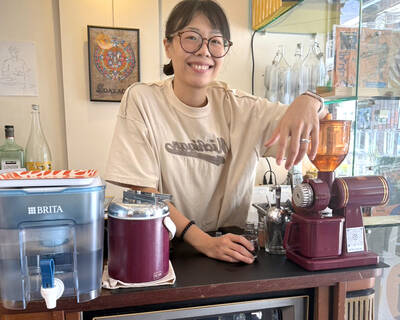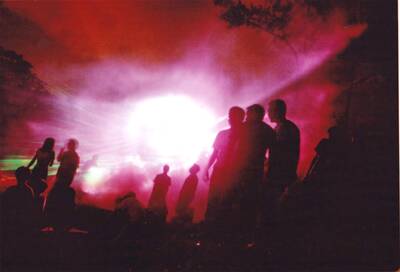Scientists have identified the maximum mix of heat and humidity a human body can survive.
Even a healthy young person will die after enduring six hours of 35-degree Celsius warmth when coupled with 100 percent humidity, but new research shows that threshold could be significantly lower.
At this point sweat — the body’s main tool for bringing down its core temperature — no longer evaporates off the skin, eventually leading to heatstroke, organ failure and death.

Photo: AFP
This critical limit, which occurs at 35 degrees of what is known “wet bulb temperature,” has only been breached around a dozen times, mostly in South Asia and the Persian Gulf, said Colin Raymond of NASA’s Jet Propulsion Laboratory.
None of those instances lasted more than two hours, meaning there have never been any “mass mortality events” linked to this limit of human survival, said Raymond, who led a major study on the subject.
But extreme heat does not need to be anywhere near that level to kill people, and everyone has a different threshold depending on their age, health and other social and economic factors, experts say.
For example, more than 61,000 people are estimated to have died due to the heat last summer in Europe, where there is rarely enough humidity to create dangerous wet bulb temperatures.
But as global temperatures rise — last month was confirmed on Tuesday as the hottest in recorded history — scientists warn that dangerous wet bulb events will also become more common.
The frequency of such events has at least doubled over the last 40 years, Raymond said, calling the increase a serious hazard of human-caused climate change.
Raymond’s research projected that wet bulb temperatures will “regularly exceed” 35C at several points around the world in the coming decades if the world warms 2.5C degrees above preindustrial levels.
‘REALLY, REALLY DANGEROUS’
Though now mostly calculated using heat and humidity readings, wet bulb temperature was originally measured by putting a wet cloth over a thermometer and exposing it to the air. This allowed it to measure how quickly the water evaporated off the cloth, representing sweat off of skin.
The theorized human survival limit of 35C wet bulb temperature represents 35C of dry heat as well as 100 percent humidity — or 46C at 50 percent humidity.
To test this limit, researchers at Pennsylvania State University in the US measured the core temperatures of young, healthy people inside a heat chamber.
They found that participants reached their “critical environmental limit” — when their body could not stop their core temperature from continuing to rise — at 30.6C wet bulb temperature, well below the previously theorized 35C.
The team estimated that it would take between five to seven hours before such conditions would reach “really, really dangerous core temperatures,” said Daniel Vecellio, who worked on the research.
THE MOST VULNERABLE
Joy Monteiro, a researcher in India who last month published a study in Nature looking at wet bulb temperatures in South Asia, said that most deadly heatwaves in the region were well below the 35C wet bulb threshold.
Any such limits on human endurance are “wildly different for different people,” he said.
“We don’t live in a vacuum — especially children,” said Ayesha Kadir, a pediatrician in the UK and health advisor at Save the Children.
Small children are less able to regulate their body temperature, putting them at greater risk, she said.
Older people, who have fewer sweat glands, are the most vulnerable. Nearly 90 percent of the heat-related deaths in Europe last summer were among people aged over 65.
People who have to work outside in soaring temperatures are also more at risk.
Whether or not people can occasionally cool their bodies down — for example in air conditioned spaces — is also a major factor. Monteiro pointed out that people without access to toilets often drink less water, leading to dehydration.
“Like a lot of impacts of climate change, it is the people who are least able to insulate themselves from these extremes who will be suffering the most,” Raymond said. His research has shown that El Nino weather phenomena have pushed up wet bulb temperatures in the past. The first El Nino event in four years is expected to peak towards the end of this year.
Wet bulb temperatures are also closely linked to ocean surface temperatures, Raymond said.
The world’s oceans hit an all-time high temperature last month, beating the previous 2016 record, according to the European Union’s climate observatory.

Cheng Ching-hsiang (鄭青祥) turned a small triangle of concrete jammed between two old shops into a cool little bar called 9dimension. In front of the shop, a steampunk-like structure was welded by himself to serve as a booth where he prepares cocktails. “Yancheng used to be just old people,” he says, “but now young people are coming and creating the New Yancheng.” Around the corner, Yu Hsiu-jao (饒毓琇), opened Tiny Cafe. True to its name, it is the size of a cupboard and serves cold-brewed coffee. “Small shops are so special and have personality,” she says, “people come to Yancheng to find such treasures.” She

In July of 1995, a group of local DJs began posting an event flyer around Taipei. It was cheaply photocopied and nearly all in English, with a hand-drawn map on the back and, on the front, a big red hand print alongside one prominent line of text, “Finally… THE PARTY.” The map led to a remote floodplain in Taipei County (now New Taipei City) just across the Tamsui River from Taipei. The organizers got permission from no one. They just drove up in a blue Taiwanese pickup truck, set up a generator, two speakers, two turntables and a mixer. They

Former Chinese Nationalist Party (KMT) chairwoman Hung Hsiu-chu’s (洪秀柱) attendance at the Chinese Communist Party’s (CPP) “Chinese People’s War of Resistance Against Japanese Aggression and the World Anti-Fascist War” parade in Beijing is infuriating, embarrassing and insulting to nearly everyone in Taiwan, and Taiwan’s friends and allies. She is also ripping off bandages and pouring salt into old wounds. In the process she managed to tie both the KMT and the Democratic Progressive Party (DPP) into uncomfortable knots. The KMT continues to honor their heroic fighters, who defended China against the invading Japanese Empire, which inflicted unimaginable horrors on the

Hannah Liao (廖宸萱) recalls the harassment she experienced on dating apps, an experience that left her frightened and disgusted. “I’ve tried some voice-based dating apps,” the 30-year-old says. “Right away, some guys would say things like, ‘Wanna talk dirty?’ or ‘Wanna suck my d**k?’” she says. Liao’s story is not unique. Ministry of Health and Welfare statistics show a more than 50 percent rise in sexual assault cases related to online encounters over the past five years. In 2023 alone, women comprised 7,698 of the 9,413 reported victims. Faced with a dating landscape that can feel more predatory than promising, many in